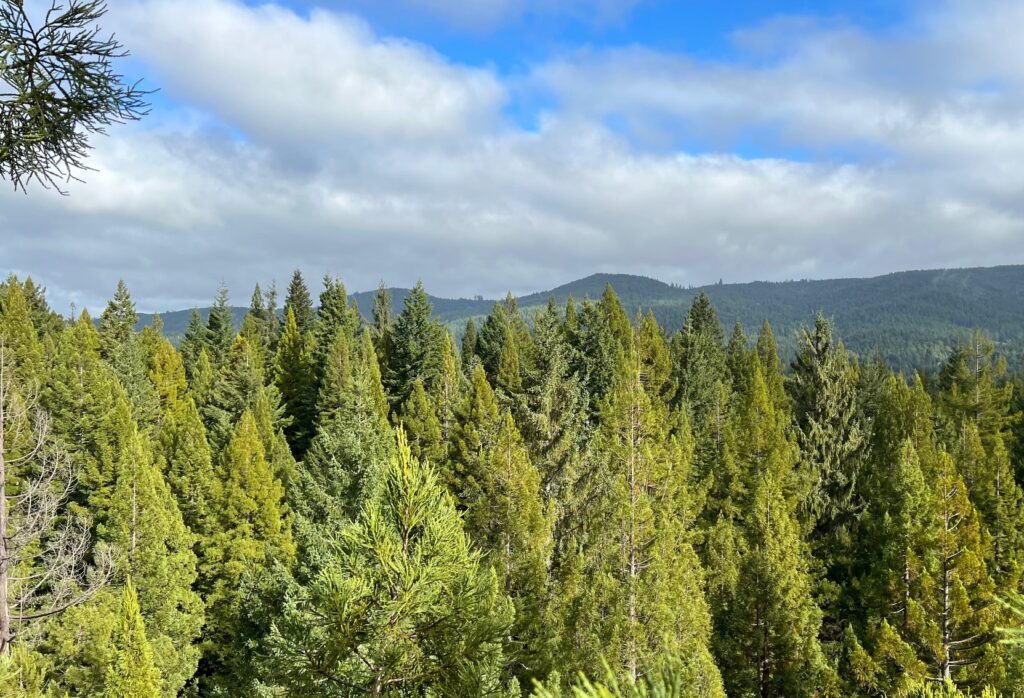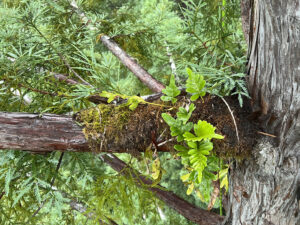
Fall 2022 ForestLife
Reaching for the Sky on California van Eck
Twenty years ago, Fred van Eck entrusted the conservation and stewardship of some 9,400 acres of extraordinary forestland in Oregon and California to the Pacific Forest Trust. With a mandate to restore older, more natural forest conditions and due consideration for economic return, we’ve been steadily demonstrating a number of new approaches to forest management, illustrating how to manage for the benefit of the whole forest, as well as the trees.
The forests serve as living laboratories to pioneer forest restoration from the ground up. The California forest has been our testing ground for the development of forest carbon offsets under the state’s system (it was the first to be registered) and illustrates how such working forest conservation easements serve as the foundation for restoring wildlife habitat to support state and federal Endangered Species Act implementation (see Forest Life Summer 2019). And all while we’ve undertaken on-going timber harvest. This past year, we began focusing on two new aspects of restoration that bring back the diversity and resilience of the redwood forest: establishing key anchor points for biodiversity to endure hundreds of years and beyond and re-establishing the forest canopy layer.
The first is based on the recognition that in an old, natural forest, a single tree in any given acre is likely to be the locus of most of the biodiversity, as well as the carbon stocks—up to half the carbon, in fact. There is a clear synergy between age, carbon stocks, and biodiversity. The second is the recognition that the forests exist not only in its trees—the primary commercial output—but also in the understory, soils, and canopy, which all play key roles in keeping the forest healthy, diverse, and resilient.
Working with Steve Sillett, Ph.D., and Marie Antoine, MS, of Humboldt Polytechnic University, we are identifying key trees throughout the forests (not just in the stream zones) that will be allowed to grow for as long as they can—hundreds to thousands of years, in the case of redwoods. Selected for their promise of quickly developing the height and structure of the old growth that provide the backbone of the diversity of the original redwood forests, these trees will evolve to be individual old growth champions across a forest landscape that is managed overall to become older, more natural, and complex. And in these trees, we are also seeding the development of the canopy reestablishment.
Key to restoring the canopy is getting back the “system engineer” of the old redwood forests, Polypodium scouleri. These ferns, commonly known as leather leaf ferns, form huge mats in the top of trees in old growth forests—as large as 8 feet or more. Fern mats collect and hold massive amounts of water and some soil. This water is key to keeping redwood forests cool and moist in the summer. The soil is the basis for other flowering plants to take root and form arboreal gardens, feeding birds, insects, amphibians, and mammals that like to climb.

Called “the eighth continent” by former PFT Board member Meg Lowman for its vast biodiversity, the forest canopy is one which relatively few people visit.
Typically, these fern mats appear in older forests, taking over one-hundred years to emerge and develop. They are not found in younger, more simplified, intensively managed forests. Working with Sillett, Antoine, and Giacomo Renzullo of BWA, we’ve pioneered the transplantation of Polypodium fern mats (carefully collected with licenses and cultivated by Giacomo) into some of our champion redwoods. Now, we will monitor their success, learn, and build on that learning to restore this essential and vibrant component of the old redwood forests. In addition to supporting unique wildlife, this canopy layer, with its ability to collect and hold water, is likely key to redwood success and survival in a warming and drying climate.
Integrating ecological outputs enables these forests—and their inhabitants—to better withstand the stress that climate change is increasingly bringing, from intense heat waves to massive downpours. And it is good business for communities and mills as well. With this careful management, we’ve harvested over 46 million board feet while quadrupling stocking in Oregon and more than doubling stocking in California, increasing both ecologic and economic returns.

